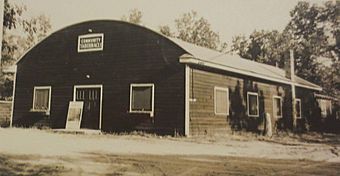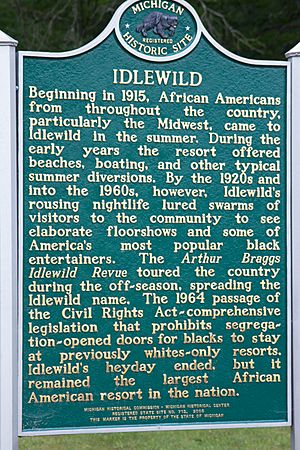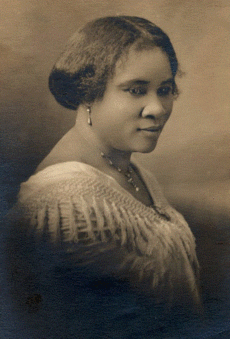Idlewild, Michigan facts for kids
Idlewild is a small community in Michigan, located near Baldwin. For many years in the past, it was a special place where African-Americans could go on vacation and buy land. This was very important because, at the time, many other places in the country did not allow African Americans to visit or own property due to unfair rules. This changed after the Civil Rights Act of 1964 made discrimination illegal.
People called Idlewild the "Black Eden of Michigan." From 1912 to the mid-1960s, it was a lively place all year round. Famous entertainers and professionals from all over the country came to visit. At its busiest, Idlewild was one of the most popular resorts in the Midwest. As many as 25,000 people would come in the summer. They enjoyed camping, swimming, boating, fishing, horseback riding, roller skating, and fun night-time shows. When the 1964 Civil Rights Act allowed African Americans to visit other resorts, Idlewild became less busy.
Today, Idlewild is quieter, but it is not a "ghost town." Many buildings are empty, but people still live there. The Idlewild African American Chamber of Commerce works to help local businesses and bring more visitors. They hope to make the town lively again with special events.
Contents
How Idlewild Began (1912–1920s)
Idlewild was started in 1912. At this time, many African Americans had good jobs and owned businesses. However, they faced racial segregation, which meant they were kept separate from white people. This made it hard for them to travel or relax at most vacation spots.
Four white land developers saw this problem and decided to create a special place. Erastus and Flora Branch, Adelbert and Isabelle Branch, Wilbur M. and Mayme Lemon, and A.E. and Modolin Wright started the Idlewild Resort Company (IRC). They bought a lot of land to create the resort.
One fun story says the name "Idlewild" comes from "idle men and wild women." Today, people in Idlewild sell T-shirts with this phrase during their summer festivals!
The IRC invited African American professionals from big cities like Detroit and Chicago. They showed them the beautiful land and sold them lots. Their ads offered land for just $1 down and $1 a month. They told people about the great hunting, fishing, boating, and horseback riding. A 1919 flyer called Idlewild "the hunter's paradise" with "beautiful lakes of pure spring water." They also promised a place where Black people could feel truly free and like "American citizens."
Important Early Residents
One very important person who moved to Idlewild was Dr. Daniel Hale Williams. In 1893, he was the first surgeon in the United States to perform open-heart surgery. Dr. Williams and other professionals were among the first to join the IRC's tours. Later, trains brought visitors from many cities, including Chicago and St. Louis.
The IRC bought over 2,700 acres (11 km2) of land. They sold much of it and then gave an island in Idlewild Lake to Dr. Williams and others. These men formed the Idlewild Improvement Association (IIA) and built a clubhouse. The IIA sold property to famous people like NAACP co-founder W.E.B. Du Bois and Madam C.J. Walker. Madam C.J. Walker was the first self-made U.S. woman millionaire of any race.
The IIA also encouraged other leaders to come to Idlewild. These new residents helped the community grow and develop. In the 1920s and 1930s, Reverend Robert L. Bradby organized the annual Idlewild Chautauqua. These week-long events brought intellectual discussions and entertainment, attracting people from all over the country.
Idlewild's Golden Age (1920s–1964)
During the time of Jim Crow Laws, which enforced segregation, it was very hard for African Americans to succeed in American society. Many looked for a safe place to live and vacation. Idlewild became that safe place. It was close to big cities like Chicago but hidden in the woods. Many educated and successful Black people moved there. For them, owning land in Idlewild meant having a special social status that segregation often denied them elsewhere. This is why Idlewild became known as the "Black Eden of Michigan."
Idlewild became famous across the country between World War I and World War II. People from over 34 states owned land there. Many clubs and bars, like the Purple Palace and the Paradise Club, offered summer entertainment. They also created jobs for people living in Idlewild all year or just for the summer.
Growing Community and Transport
By 1923, the Pere Marquette Railway built a train line to the area. A post office opened that same year, and soon after, Idlewild got its own fire department. With these new services, more African American business owners came to the community. Idlewild started to look like a busy American town. By the mid-1920s, over 6,000 people had bought about 17,000 lots of land.
The Pere Marquette Railway ran a special train called the Resort Special from Chicago and Detroit to Baldwin, which was five miles from Idlewild. This train ran from June to September. Trains also went west from Idlewild to Ludington and east to Saginaw.
After World War II, Idlewild attracted a new group of African Americans who were working-class but still doing well. New paved roads, better electricity, and a renovated post office encouraged more businesses to open. People like Phil Giles and Arthur "Big Daddy" Braggs bought land and turned areas into exciting nightspots and business centers.
In 1952, the Detroit Idlewilders Club was started by Sunnie Wilson and other people from Detroit who spent their summers in Idlewild. This group helped support charities and social events in Idlewild.
John O. Meeks, a local businessman, remembered Idlewild's past in 2017. He said, "At its high point, between the '40s and early '60s, nearly 30,000 folks would descend on here in the summer. Hundreds of black-owned businesses thrived. This place was hopping." He also mentioned a roller-skating rink, their own fire department, and a post office.
Famous Entertainers and Shows
Many famous African American entertainers performed in Idlewild, especially at the Paradise Club, run by Arthur Braggs. The Flamingo Club also had great performers like LaVern Baker. The list of stars included Della Reese, Jackie Wilson, The Four Tops, Sarah Vaughan, Louis Armstrong, Dinah Washington, B.B. King, and Aretha Franklin. These performers entertained both Idlewild residents and white visitors from nearby towns. Arthur Braggs created amazing shows with singers, dancers, and showgirls at the Paradise Club, making Idlewild known as the "Summer Apollo of Michigan." One resident said, "It wasn’t about race, it was about fun."
The Paradise Club's showgirls and dancers also toured in other cities like Montreal, Toronto, and New York, even performing at the famous Apollo Theater. These shows helped Idlewild become a major entertainment center and brought a lot of money to the area.
Some of the places to stay and visit in Idlewild were even advertised in The Negro Motorist Green Book. This book helped African American travelers find safe places to eat, sleep, and get gas during segregation.
Changes and New Beginnings (1964–Present)
After the Civil Rights Act of 1964 became law, things changed for Idlewild. Now, other vacation resorts had to welcome African-American visitors. Many people started going to places like Florida beaches and Las Vegas casinos instead of Idlewild. As National Public Radio said, "it was integration that killed Idlewild."
In 1966, Idlewild lost its last nearby train service in Baldwin. The national economic problems in the early 1970s also made things harder for Idlewild. Fewer jobs meant fewer people living there. Idlewild became more of a quiet family vacation spot and a place for retirees who remembered its busy past.
In the 1970s, local leaders started plans to improve the community. They got grants to fix roads and make other changes. The island in Idlewild Lake was even renamed "Williams Island" to honor Dr. Daniel Hale Williams. In the 1990s, they focused on fixing up existing buildings. The government also helped bring sewer and natural gas systems to the area.
Businessman John O. Meeks bought and fixed up the Morton Motel. He also started groups like the Idlewild African American Chamber of Commerce to help the community grow. Even though many businesses closed, like the Paradise Club, people are still working to bring life back to Idlewild.
In 2013, the state of Michigan created a 10-year plan to help tourism in Idlewild. The Idlewild Historic and Cultural Center is open on Saturdays and offers tours. It shows old photos and items from the town's busiest years. The National Idlewilders Club still organizes events every year.
In 2017, John O. Meeks told the New York Post, "We have three motels here now. There used to be 35. We have one restaurant. There used to be 25. I don’t expect it to be what it once was, but I do believe it deserves a future." While many houses are empty, its beautiful lakes are still home to a few hundred people.
In 2019, a radio station described Idlewild as a "ghost town" because many homes were empty. However, many events were planned for 2019, like the 5th Annual Idlewild Education, Empowerment and Music Festival.
A 2011 article summed up Idlewild's importance. It said that even with its decline, Idlewild showed how a community could become successful by offering a special place for people to relax and enjoy themselves.
Climate
This area has big changes in temperature throughout the year. Summers are warm to hot and often humid. Winters are cold, sometimes very cold. According to the Köppen Climate Classification system, Idlewild has a humid continental climate.
| Climate data for Idlewild, Michigan | |||||||||||||
|---|---|---|---|---|---|---|---|---|---|---|---|---|---|
| Month | Jan | Feb | Mar | Apr | May | Jun | Jul | Aug | Sep | Oct | Nov | Dec | Year |
| Mean daily maximum °C (°F) | −2 (29) |
0 (32) |
6 (42) |
14 (57) |
21 (70) |
26 (79) |
28 (83) |
27 (81) |
23 (73) |
16 (61) |
7 (45) |
1 (33) |
14 (57) |
| Mean daily minimum °C (°F) | −12 (11) |
−12 (10) |
−7 (19) |
−1 (31) |
6 (42) |
11 (51) |
12 (54) |
12 (53) |
8 (46) |
2 (36) |
−3 (27) |
−8 (17) |
1 (33) |
| Average precipitation mm (inches) | 56 (2.2) |
43 (1.7) |
53 (2.1) |
71 (2.8) |
71 (2.8) |
86 (3.4) |
71 (2.8) |
79 (3.1) |
86 (3.4) |
74 (2.9) |
74 (2.9) |
53 (2.1) |
820 (32.2) |
| Source: Weatherbase | |||||||||||||
Education
All of Yates Township, including Idlewild, is part of the Baldwin Community Schools school district.
Images for kids










